
Monoculture Farming In Agriculture Industry
Monoculture farming is one of the most disputable topics in today’s agriculture industry. As the world’s population augments in number and the demand for food on the global scale keeps rising, many farmers deem monoculture agriculture to be the simplest solution for satisfying this constantly growing need for victuals. Yet, as with every important issue that has an influence on people’s livelihood, a closer look should be taken at the concept of monoculture farming, at its pros and cons, and on its major alternative – polyculture. This article covers these and some other crucial issues related to the topic. Let’s start from a general point and find out what monoculture farming is in the first place.
What Is Monoculture Farming?
Monoculture farming is a form of agriculture that is based on growing only one type of a crop at one time on a specific field. In contrast, a polyculture system assumes that a field is sown with two or more crops at a time. It should be noted that the concept of monoculture does not only apply to crops, but to farm animals as well: it consists in breeding only one species of animals on a given farm, be it dairy cows, sheep, pigs, chicken, etc.
When talking about monoculture crops, it is important to note that even if a different culture is planted on a given field plot each year, the concept of growing a single crop on one field at a time is still referred to as “monoculture”.
Having outlined the notion of monoculture farming, let’s see what are the main advantages and disadvantages of this method of growing crops.
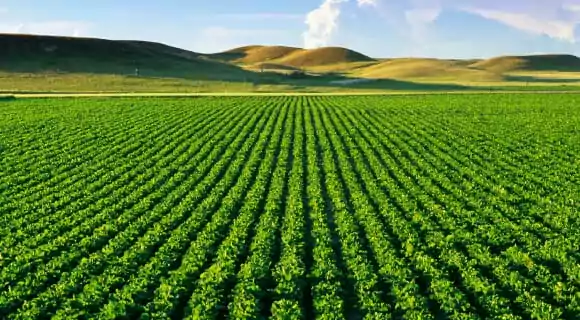
Advantages Of Monoculture Farming
Increased Productivity And Efficiency
Monoculture planting maximizes the efficient use of soil and local climate conditions. In most cases, farmers select the crop that will thrive best in the local environment. The positive effects of monoculture farming are often seen in rice growing (grown in conditions similar to those of wetlands) and wheat growing (which is grown in flat areas with plenty of sunlight). Plants that can resist or thrive in specific weather conditions (e.g. drought, winds or colder average temperatures) become the focal point of the agricultural monoculture system. In contrast, a traditional farmer is concerned with crop variety and implements a complex schedule of planting, maintenance, and harvesting to maximize the production of different crops. Despite this increased effort, the productivity and efficiency of monoculture farming is usually higher.
Open A Room For New Technologies
When growing monoculture crops, agrarians tend to have some extra time and financial resources to refer to new technologies in agriculture helping them to maximize their agricultural performance. Among the newest technical solutions in the service of farmers are drones, ground sensors, and satellite-derived data. One of the most innovative and comprehensive technologies in this matter are satellite tools that are used for a complex monitoring of specific fields and management of all the stages of sowing and growing crops on them. A bright example of such new technologies is our crop monitoring software, which is a high-performance tool that assists farmers with their day-to-day activities both on large and small farmlands in any corner of the globe.
EOSDA Crop Monitoring
Fields analytics tool with access to high-resolution satellite images for remote problem areas identification!
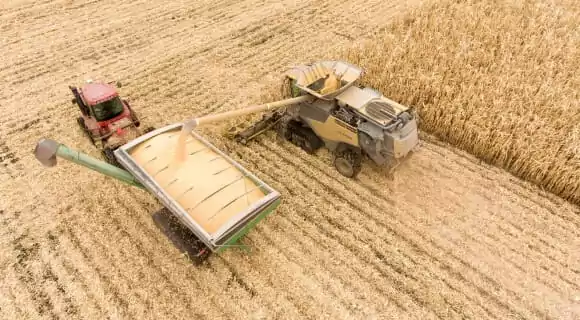
Specialized Production
Industrial monoculture planting allows farmers to specialize in a particular crop, as they usually deal with the same issues and problems that may arise in the process of growing. The advantage of such specialization is that it increases profits and reduces costs, given that no additional machinery or other resources are required except for those needed to work with this specific kind of crop. Moreover, when a single crop is cultivated in a field, it is easier to conduct a satellite monitoring of its health and development. This approach in EOSDA Crop Monitoring is based on 5 main indices (NDVI, MSAVI, NDRE, ReCl); each of them is more applicable to the particular stages of plant growth. Also, these vegetation indices correlate with the Growth Stages feature in EOSDA Crop Monitoring, which is specific for each crop.

Yields Maximization
Some types of crops, such as cereals for example, are deemed to have better yields when sown and grown as monocultures, i.e. without other crops adjacent to them on a field. However, such maximization of yields with monoculture planting can only be achieved on the condition of yearly rotation of at least two different crops on the given farmland. In this regard, it is also worth noting that with the EOSDA Crop Monitoring software farmers can generate productivity maps to identify the field plots with better performance. Such productivity maps allow farmers to plant their seeds with greater precision that potentially will result in higher yields.
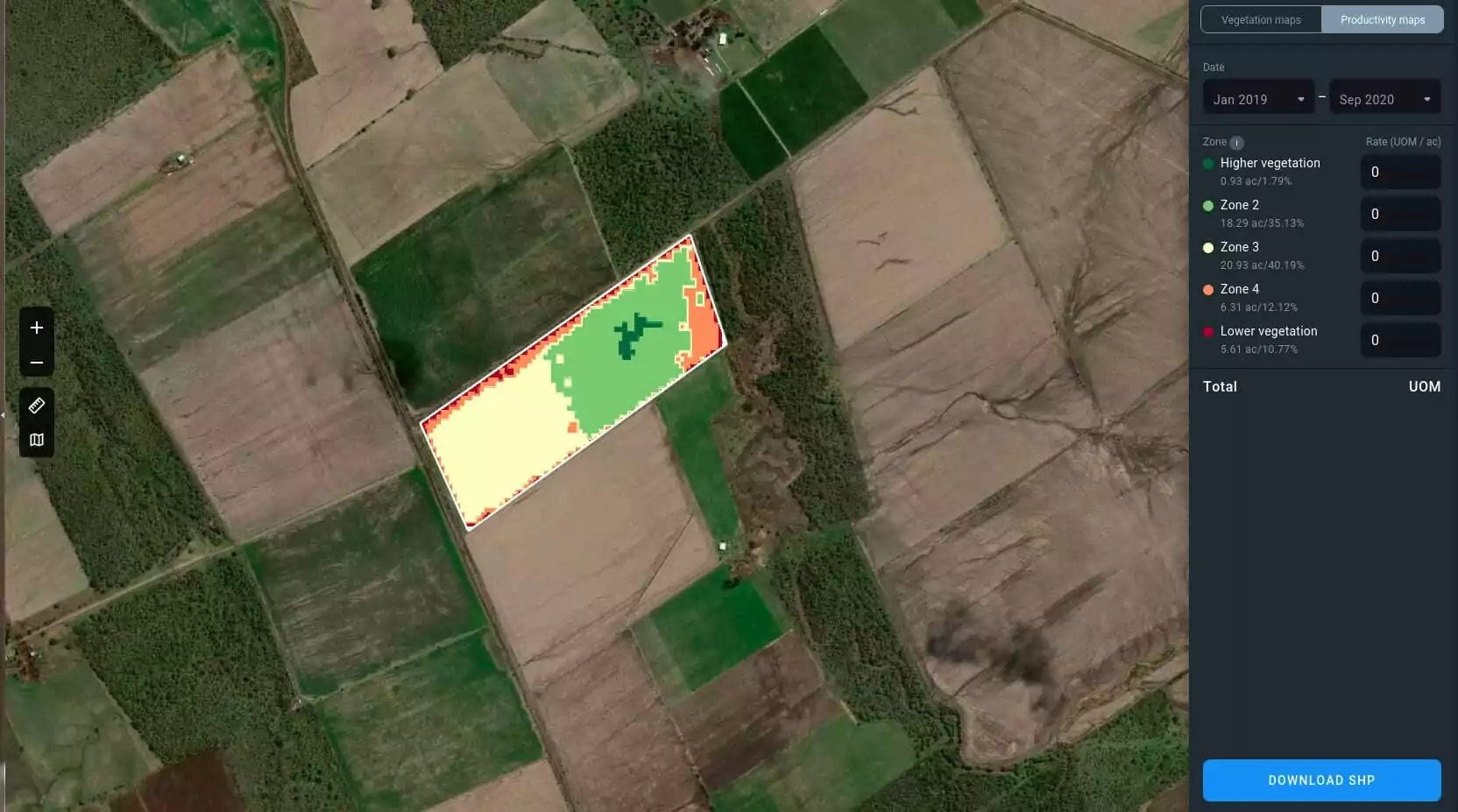
Easier To Manage
Cultivating monoculture crops is easier as compared to polyculture ones. This relative simplicity in monoculture farming is explained by the fact that growing only one kind of a crop demands less efforts, knowledge, and resources than cultivating various sorts of plants. For example, monoculture planting requires less machinery for soil preparation or harvesting, while growing various crops at a time requires different types of machines. The same is true for irrigation and pest control.
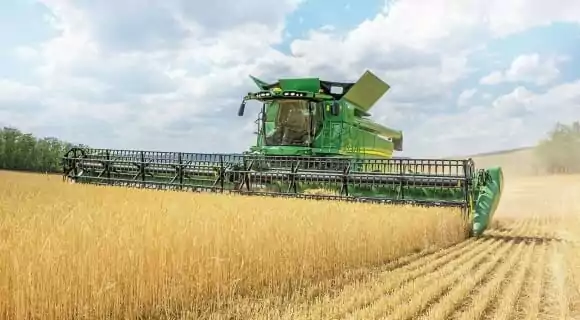
Higher Revenues
By growing monoculture plants, farmers usually benefit from higher profits. For example, cultivating a single kind of crop that is best suited to development in specific climate conditions, allows the farmer to get better yields and, therefore, get higher income.
Disadvantages Of Monoculture Farming
Pests Management
Farmers who stick to monoculture farming face more difficulties in terms of struggling with pest infestations on their field. Pests are most prolific on farmlands having only one single kind of crop grown on them year after year. In fact, it’s no wonder, as parasites have their favorite type of food in one place during a long period of time and, in consequence, reproduce themselves more efficiently. Also, in the context of protection from field parasites, monoculture planting lacks some important aspect that polyculture farming can boast of – genetic diversity of plants. Polyculture, for example, may provide for some types of plants on the field that repel pests. Such plants thus serve as a natural barrier to development of pest infestations on farmlands.
Higher Pesticides Use
Monoculture crops are more likely to be affected by blight or pests, as these threats can move faster through the area due to its reduced biodiversity. In response, farmers apply greater amounts of pesticides and herbicides to protect the crop. These chemicals seep into the ground, contaminating both the soil and the groundwater. Moreover, monoculture farms tend to intensify even more the use of pesticides, as some kinds of pests survive the use of chemicals by developing resistance to them. Later, these parasites pass this newly acquired immunity to their offspring which, in their turn, will proliferate on the given field plot even more, as their main source of food keeps staying in one place.
Soil Degradation And Fertility Loss
Agricultural monoculture upsets the natural balance of soils. Too many of the same plant species in one field area rob the soil of its nutrients, resulting in decreasing varieties of bacteria and microorganisms that are needed to maintain fertility of the soil. The production of a single plant species over a large area also has a negative effect on the structure of the underlying soil. One species of crop means that only one type of root will be available to trap moisture and prevent soil erosion, work that typically requires multiple types of roots.
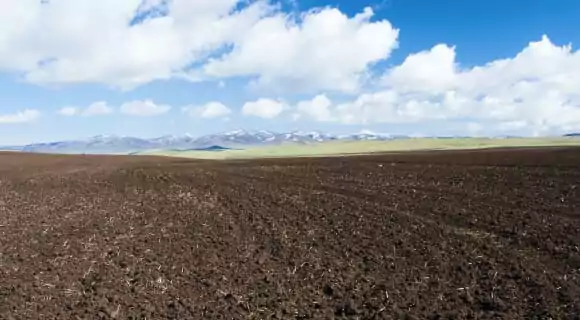
Higher Use Of Fertilizers
Intensive use of fertilizers on monoculture fields is tightly connected with the previous point. As growing only one kind of plant on the same piece of farmland depletes and exhausts the soil by depriving it of the biodiversity, farmers tend to artificially boost the fertility of their impacted fields by applying chemical fertilizers. The use of such artificial nutrients has a negative impact on the natural composition of the soil, and therefore has a devastating effect on the ecosystem in general. In addition, it should be noted that the longer a monoculture farm grows a single kind of crop on the same field plots, the more chemical fertilizers they have to use, as from year to year such lands are worn out and depleted in a progressive manner.
Higher Water Use
If there is only one type of crop on a given land plot, the root systems of this species are not sufficient to maintain the soil structure around the plants, which can lead to erosion and loss of water uptake. For this reason, the soil around monoculture crops is often devoid of the significant layer of topsoil, which causes imbalance in water retention on such farmlands. In order to combat this loss of water, farmers have to use larger amounts of this important resource. Such an increased need for water means that local sources, such as lakes, rivers, and reservoirs, are overused to meet immediate demand. This depletion has additional negative consequences for the ecosystems of these water sources.

Decrease In Biodiversity
The key aspect of nature is its biological diversity and agriculture sector is no exception to this. The more varied biological species are present in a given area, the stronger and richer the ecosystem of this area is. One of the main problems with monoculture farming is the elimination of biological diversity. Sufficient variety of specific plants, animals, and insects in a particular environment helps to control excessive proliferation of pests, crop diseases, and other negative manifestations caused by disruption of the natural balance of soils on monoculture farmlands.
Impact On Pollinators
Monoculture farming has also a negative effect on such important participants of the natural reproductive cycle as bees and other pollinators. The increasing use of pesticides, herbicides, and other chemical substances in monoculture farming, which are called to maintain the crop growth and the fertility of “impoverished” soils, damages the health of pollinating insects and often kills them. Also, in case of a monoculture planting system, there are a lot of single-plant fields stretching for miles and miles in all directions. In such a situation, pollinators find themselves facing a homogeneous food territory and suffer from deficiencies due to the poor diversity of their diet.
Also, such a lack of biodiversity in the natural habitat of bees and other pollinators, results in the deficit of some bacteria that are beneficial for their health, namely Bifidobacterium or Lactobacillus. Moreover, the lack of the needed microorganisms causes a much faster deterioration of the food in beehives, which in turn leads to food shortages for bees and additionally weakens the immune system of these precious insects.
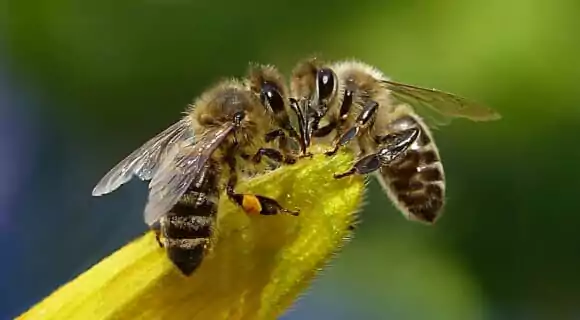
Economic Risks
When concentrated on growing monoculture crops only, a farmer puts at stake all the potential harvest from the given land plots and the reason for this is quite simple. Imagine that something goes wrong during crop development (exceptional drought, extensive rains, specific pest infestations, etc.) – there will be no chances that some crops will survive by showing themselves more resilient than others, as there are simply no other crops in such a case. Thus, monoculture farms can lose at once all their harvest and, therefore, their income for the whole season, which is quite risky for farmers from the economic point of view.
Environmental Impacts Of Monoculture
In most subsistence farming practices, crops are grown and harvested to feed a family or local community. In monoculture agriculture, however, the crop is produced for commercial purposes, which gives an exploitative aspect to the whole process of using farmlands to grow monoculture crops. Farmers often use unsmart practices with their monoculture farming as well.
Once the harvest is reaped, it will be transported long distances to a large number of destinations. Often, as in the case of avocado farming, these destinations are international, which substantially increases the number of transport miles. This form of transportation (whether land vehicle or sea going vessel) relies heavily on fossil fuels such as oil and gas which are among the main contributors to environmental pollution when combusted. The use of fossil fuels is also considered one of the main causes of greenhouse effect in the atmosphere that has been linked to global climate change due to agricultural activities on the planet.
Reducing The Effects Of Monoculture Farming
In general, the impact of monoculture farming depends on its intensity. By intensity here is meant the extension of the time period during which one and the same crop is grown on a specific land plot. If, for example, a monoculture crop is grown on the same farmland year after year without change, it is considered as the worst form of this agricultural practice that has the biggest impact on the soil and the surrounding ecosystem. This agricultural method is also called “monocropping” or continuous monoculture.
Let’s see now what the solutions are for avoiding or diminishing the negative effects of monoculture on the environment.
Implementation Of Crop Rotation
Alternating different types of crops on a given field may substantially help to avoid some major negative impacts of monoculture on soils. Yearly crop rotation, for example, interrupts pest cycles and contributes to maintaining the soil in a more balanced state in terms of its composition. There are many types of crop rotation schemes and the majority of farms opt for the ones that best suit their local environmental conditions.
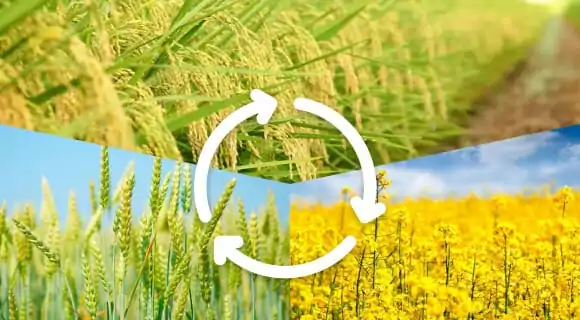
Smart Use Of Fertilizers
The current approaches to applying chemical fertilizers on fields, and in particular on monoculture crops, should change as the use of such substances is very harmful to ecosystems. With current technologies, such change has now become possible, and fertilizers can be used in a much smarter way, as there is no more need to apply the same amount of fertilizer to each acre. EOSDA Crop Monitoring has a zoning feature that allows effective application of fertilizers only in the areas where they are really needed. It is possible due to the satellite monitoring of the field and creating a vegetation map that shows how well or badly the plants are developing.
Moderate Herbicides And Pesticides Use
Given that the increased use of artificial pesticides and herbicides not only damages ecosystems, but negatively impacts the interests of farmers themselves (the quality of soils becomes worse, which results in poorer harvest), some counter actions should be taken in this regard. The negative effects of overusing these artificial substances in monoculture farming can be significantly diminished by their much more moderate application or even by switching to organic herbicides and pesticides. The positive effects of changing the approach to using these substances in monoculture farming can be intensified by crop rotation, as it contributes to natural protection of crops against pests and diseases.
More Efficient Water Use
The efficient use of such an important natural resource as water is one of the crucial issues in the agriculture sector, especially in monoculture farming. The solution here would be to grow crops near the water bodies to decrease the use of groundwater and to diminish the runoff of water absorbed by the soil (i.e. to ensure that it remains longer in the soil). Such diminishing can be primarily achieved opting for rotative monoculture planting instead of monocropping.

Shifting Away From Monoculture
Despite some benefits of monoculture for industrial agriculture, the environmental disadvantages of this method of farming in the long run outweigh its positive aspects. That is why it is important to move to smarter agricultural approaches and practices. Although it may seem obvious, it’s worth mentioning that the best alternative to monocultures is a polyculture system, i.e. constant alternation of different types of crops in the given farmlands.
Polyculture helps different species of crops complement each other and make better use of soil nutrients. An example of departure from monocultures in the European Union is the “greening” initiative or “green payment”, which consists in providing an annual subsidy to farmers who incorporate planet-friendly approaches and methods of growing crops. Let’s hope that such positive initiatives, both from official authorities and farmers themselves, will only multiply and lead to tangible positive changes in the agricultural sector all over the planet.
About the author:
Petro Kogut has a PhD in Physics and Mathematics and is the author of multiple scientific publications. He is the Soros Associated Professor as well as the head of the department of differential equations in the Oles Honchar Dnipro National University and has received a number of grants, prizes, honorary decorations, medals, and other awards. Prof. Dr. Petro Kogut is a science advisor for EOSDA.
Recent articles

Analyze 2025 & Plan Your Best Year Yet: LandViewer Christmas Offer
It’s the most wonderful time of the year! The Christmas holidays are here, and so is your chance to analyze 2025 and plan a prosperous 2026 with more affordable Pro plans in LandViewer.

EOSDA Models Climate Change Impact On Sugarcane Yields
EOSDA modeled future temperature, rainfall, and other climate impacts on Veracruz sugarcane. The results help growers plan long-term adaptation strategies, including timing, varieties, and irrigation.

EOSDA LandViewer Black Friday Sale: Exclusive Offers & Giveaway
This Black Friday, LandViewer offers new users the chance to save on monthly plans, get extra months with yearly subscriptions, and participate in a free annual plan giveaway.